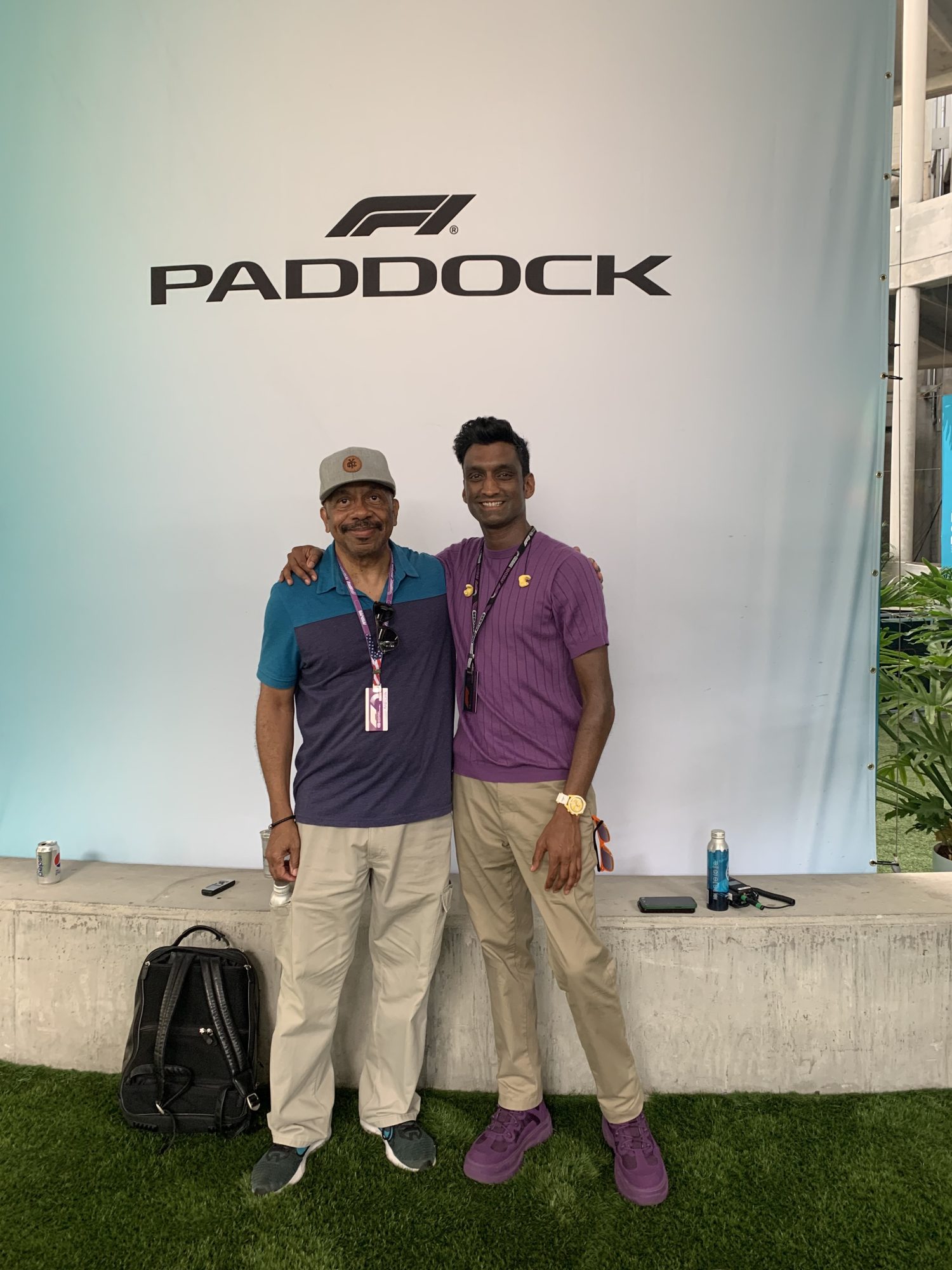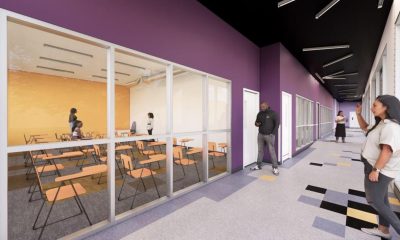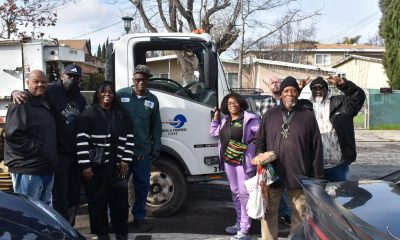#NNPA BlackPress
Miami Grand Prix 2023
NNPA NEWSWIRE — The only Black man to have raced in Formula 1, British driver Lewis Hamilton, 38, has won more and been the fastest qualifier more times than any other driver, triggering racist social-media diatribes from motorsports fans used to their Nomex-clad heroes being White-only.
The post Miami Grand Prix 2023 first appeared on BlackPressUSA.

MIAMI GARDENS, FL – Chattering happily, rocking garb worn to ward off an unrelenting South Florida sun, scores of Black faithful exuberantly trudge toward their place of Sunday worship – Hard Rock Stadium, home of the NFL’s Miami Dolphins.
The 20 helmeted deities to be exalted this afternoon probably couldn’t toss a perfect spiral if their lives depended on it, and their average weight is a dinky 148 pounds. But they drive the hell out of nimble, 1,000-horsepower winged cars better than anyone on the planet, and are led by a Black high priest whose seven world championships and 103 career victories make him the hands-down G.O.A.T.
Welcome to the Formula 1 Crypto.Com Miami Grand Prix 2023, the fifth round of a traveling circus that will hit 24 global racing venues this year and is viewed as the pinnacle of motorsport. Formula 1’s irrepressible Black king, British driver Lewis Hamilton, 38, has drawn the sport’s ire for speaking truth to power, to include kneeling atop racetracks while clad in a Black Lives Matter T-shirt, to protest the police executions of George Floyd and Breonna Taylor.
The only Black man to have raced in Formula 1, Hamilton has won more and been the fastest qualifier more times than any other driver, triggering racist social-media diatribes from motorsports fans used to their Nomex-clad heroes being White-only.
The only Formula 1 icon with 103 wins and 103 pole positions, Hamilton was victimized by an inexplicable, last-second rules change during the last lap of the last race of 2021, which was held in Abu Dhabi. As a result, Hamilton, who entered Formula 1 in 2007 and currently drives for the Mercedes-AMG Petronas team, was controversially deprived of a chance to win a record-setting eighth world championship.
His otherworldly talent, off-track fashionista flair, and even his affluence (Forbes says Hamilton raked in $55 million in 2022, excluding endorsements), spurred a noticeable Black presence among the more than 270,000 fans who attended three days of Miami Grand Prix festivities May 5, 6 and 7. Easily half of the melanated faces in the crowd were crowned by baseball caps emblazoned with Mercedes’ distinctive tri-star logo.
Without Hamilton in the field, it’s doubtful there would have been pre-race pageantry featuring Venus and Serena Williams standing near the start/finish line of a twisty, makeshift 3.36-mile asphalt track winding around Hard Rock Stadium. The Williams sisters smiled appreciatively as showman LL Cool J bombastically introduced each of the contest’s 20 drivers, while will.i.am theatrically led a string orchestra providing background music.
The Miami Grand Prix is more than a contest where cars routinely hit 210 mph while traversing a 19-turn course lined by unforgiving concrete barriers. It’s part sporting event, part over-the-top party leavened with plenty of palm trees, more celebs than you can shake a stick at, blaring reggaeton and sumptuous food and drink prepared by worldclass chefs and mixologists.
Moko, a colorfully dressed native of Senegal who’s traveling to each of Formula 1’s 24 races in 2023, wouldn’t have it any other way.
“I look at Formula 1 like art, in a way,” says Moko, who idolizes Juan Manuel Fangio, a charismatic Argentinian driver who seized the world championship in 1951, 1954, 1955, 1956 and 1957, before Moko was born. “I like the duality between the machine and the human being.
“It’s hard to explain, but I’m going to give it to you the African way — it’s like you’re dancing with the woman you love, and if you don’t dance right, the woman can kill you,” Moko laughs. “And the woman is the car!”

As for the financial impact of the Miami Grand Prix, where $100 earns you the privilege of strolling around the sprawling Miami International Autodrome campus for a single day, without getting a place to sit, Moko shrugs. “If you love something and you can afford it, why not?”
Unlike Moko, saxophone player Bismarck Morgan traveled only 60 miles from West Palm Beach. “I think there’s a great atmosphere here, and I think it’s important for people to come and make a decision for themselves,” Morgan says. “You get in and it’s a very wonderful and beautiful atmosphere. It’s easy to sit on the outside of something and have an opinion of it, but when you get there, it’s actually a beautiful place.
“There are plenty of people from around the world here, people of color from India, Dubai. It’s a beautiful thing, and I love the sound of race cars, I love the revving of the engines. It gets your blood flowing.”
Lewis Hamilton, who drives a W14 Mercedes-AMG road rocket propelled by a 1.6-liter, V6 engine and an electric motor hooked to a rechargeable battery, has noticed a change in the hue of Grand Prix crowds since he joined the Grand Prix circuit 16 years ago.
“For the first five or ten years or so, I didn’t see many people of color in the grandstands,” says Hamilton, whose Mercedes-AMG Petronas team has an annual budget exceeding $300 million. “There were very few people of color. It was not as diverse as I might have hoped.”
However, Hamilton is now “seeing a crowd that’s more diverse. That’s amazing to me to not be the only one there, which is nice to see. And it’s just great to be seeing that we’re tapping into those different cultures, those different communities, who perhaps once didn’t think (Formula 1 racing) was for them. “Because they didn’t see someone that looked like them in the sport, maybe.”
Just as Tiger Woods’ soul-crushing dominance drew more Black fans to golf tournaments, Lewis Hamilton’s championship-winning campaigns in 2008, 2014, 2015, 2017, 2018, 2019 and 2020 have lured new eyeballs to Formula 1.
So has the Netflix series “Formula 1: Drive to Survive,” which New England Patriots safety Adrian Phillips and his wife, pediatrician Camille Phillips, credit with attracting them to Miami Gardens to see Hamilton drive.
The couple watched Hamilton hustle his underperforming W14 Mercedes from 13th on the grid to a 6th-–place finish. Hamilton says that despite having subpar equipment this year, and finishing the Miami Grand Prix fourth in the driver standings with 56 points, compared with 119 for first-place Dutchman Max Verstappen, Hamilton will be back in 2024 and beyond.
Adrian and Camille Phillips say you can count them in, too.
The post Miami Grand Prix 2023 first appeared on BlackPressUSA.
#NNPA BlackPress
Beloved Actor and Activist Louis Cameron Gossett Jr. Dies at 87
NNPA NEWSWIRE — Louis Gossett Jr., the groundbreaking actor whose career spanned over five decades and who became the first Black actor to win an Academy Award as Best Supporting Actor for his memorable role in “An Officer and a Gentleman,” has died. Gossett, who was born on May 27, 1936, in Brooklyn, N.Y., was 87. Recognized early on for his resilience and nearly unmatched determination, Gossett arrived in Los Angeles in 1967 after a stint on Broadway.
The post Beloved Actor and Activist Louis Cameron Gossett Jr. Dies at 87 first appeared on BlackPressUSA.

By Stacy M. Brown
NNPA Newswire Senior National Correspondent
@StacyBrownMedia
Louis Gossett Jr., the groundbreaking actor whose career spanned over five decades and who became the first Black actor to win an Academy Award as Best Supporting Actor for his memorable role in “An Officer and a Gentleman,” has died. Gossett, who was born on May 27, 1936, in Brooklyn, N.Y., was 87. Recognized early on for his resilience and nearly unmatched determination, Gossett arrived in Los Angeles in 1967 after a stint on Broadway.
He sometimes spoke of being pulled over by law enforcement en route to Beverly Hills, once being handcuffed to a tree, which he remembered as a jarring introduction to the racial tensions of Hollywood. In his memoir “An Actor and a Gentleman,” Gossett recounted the ordeal, noting the challenges faced by Black artists in the industry. Despite the hurdles, Gossett’s talent shone brightly, earning him acclaim in groundbreaking productions such as “A Raisin in the Sun” alongside Sidney Poitier. His Emmy-winning portrayal of Fiddler in “Roots” solidified his status as a trailblazer, navigating a landscape fraught with racial prejudice.
According to the HistoryMakers, which interviewed him in 2005, Gossett’s journey into the limelight began during his formative years at PS 135 and Mark Twain Junior High School, where he demonstrated early leadership as the student body president. His passion for the arts blossomed when he starred in a “You Can’t Take It With You” production at Abraham Lincoln High School, catching the attention of talent scouts who propelled him onto Broadway’s stage in “Take A Giant Step.” His stellar performance earned him the prestigious Donaldson Award for Best Newcomer to Theatre in 1952. Though initially drawn to sports, Gossett’s towering 6’4” frame and athletic prowess led him to receive a basketball scholarship at New York University. Despite being drafted by the New York Knicks in 1958, Gossett pursued his love for acting, honing his craft at The Actors Studio under the tutelage of luminaries like John Sticks and Peggy Fury.
In 1961, Gossett’s talent caught the eye of Broadway directors, leading to roles in acclaimed productions such as “Raisin in the Sun” and “The Blacks,” alongside legends like James Earl Jones, Cicely Tyson, Roscoe Lee Brown, and Maya Angelou. Transitioning seamlessly to television, Gossett graced small screens with appearances in notable shows like “The Bush Baby” and “Companions in Nightmare.” Gossett’s silver screen breakthrough came with his role in “The Landlord,” paving the way for a prolific filmography that spanned over 50 movies and hundreds of television shows. From “Skin Game” to “Lackawanna Blues,” Gossett captivated audiences with his commanding presence and versatile performances.
However, his portrayal of “Fiddler” in Alex Haley’s groundbreaking miniseries “Roots” earned Gossett critical acclaim, including an Emmy Award. The HistoryMakers noted that his golden touch extended to the big screen, where his role as Sergeant Emil Foley in “An Officer and a Gentleman” earned him an Academy Award for Best Supporting Actor, making him a trailblazer in Hollywood history.
Beyond the glitz and glamour of Hollywood, Gossett was deeply committed to community activism. In 1964, he co-founded a theater group for troubled youth alongside James Earl Jones and Paul Sorvino, setting the stage for his lifelong dedication to mentoring and inspiring the next generation. Gossett’s tireless advocacy for racial equality culminated in the establishment of Eracism, a nonprofit organization dedicated to combating racism both domestically and abroad. Throughout his illustrious career, Gossett remained a beacon of strength and resilience, using his platform to uplift marginalized voices and champion social change. Gossett is survived by his children, Satie and Sharron.
The post Beloved Actor and Activist Louis Cameron Gossett Jr. Dies at 87 first appeared on BlackPressUSA.
#NNPA BlackPress
COMMENTARY: D.C. Crime Bill Fails to Address Root Causes of Violence and Incarceration
WASHINGTON INFORMER — The D.C. crime bill and so many others like it are reminiscent of the ‘94 crime bill, which produced new and harsher criminal sentences, helped deploy thousands of police and surveilling methods in Black and brown communities, and incentivized more states to build prisons through a massive infusion of federal funding. While it is not at the root of mass incarceration, it significantly accelerated it, forcing a generation of Black and brown families into a never-ending cycle of state-sanctioned violence and incarceration.
The post COMMENTARY: D.C. Crime Bill Fails to Address Root Causes of Violence and Incarceration first appeared on BlackPressUSA.

By Kaili Moss and Jillian Burford | Washington Informer
Mayor Bowser has signed the “Secure DC” omnibus bill passed by the D.C. Council last month. But we already know that this bill will be disastrous for all of D.C., especially for Black and brown residents.
While proponents claim that this legislation “will make D.C. residents safer and more secure,” it actually does nothing to address the root of the harm in the first place and instead maintains a cycle of violence, poverty, and broken community ties. The omnibus bill calls for increased surveillance, drug-free zones, and will expand pre-trial detention that will incarcerate people at a significantly higher rate and for an indeterminate amount of time before they are even tried. This bill will roll back decades of nationwide policy reform efforts and initiatives to keep our communities safe and whole, which is completely contradictory to what the “Secure” D.C. bill claims it will do.
What is unfolding in Washington, D.C., is part of a dangerous national trend. We have seen a resurrection of bad crime bills in several jurisdictions across the country — a phenomenon policy experts have named “zombie laws,” which are ineffective, costly, dangerous for communities of color and, most importantly, will not create public safety. Throwing more money into policing while failing to fund preventative measures does not keep us safe.
The D.C. crime bill and so many others like it are reminiscent of the ‘94 crime bill, which produced new and harsher criminal sentences, helped deploy thousands of police and surveilling methods in Black and brown communities, and incentivized more states to build prisons through a massive infusion of federal funding. While it is not at the root of mass incarceration, it significantly accelerated it, forcing a generation of Black and brown families into a never-ending cycle of state-sanctioned violence and incarceration. Thirty years later, despite spending billions each year to enforce these policies with many of these provisions remaining in effect, it has done very little to create long-term preventative solutions. Instead, it placed a permanent moving target on the backs of Black people, and the D.C. crime bill will do the same.
The bill calls for more pretrial detention. When our loved ones are held on pretrial detention, they are held on the presumption of guilt for an indeterminate amount of time before ever seeing a judge, which can destabilize people and their families. According to experts at the Malcolm Weimer Center for Social Policy at Harvard University, just one day in jail can have “devastating consequences.” On any given day, approximately 750,000 people are held in jails across the nation — a number that beats our nation’s capital population by about 100,000. Once detained, people run the risk of losing wages, jobs, housing, mental and health treatments, and time with their families. Studies show that pretrial detention of even a couple of days makes it more likely for that person to be rearrested.
The bill also endangers people by continuing a misguided and dangerous War on Drugs, which will not get drugs off the street, nor will it deter drug use and subsequent substance use disorders (SUDs). Drug policies are a matter of public health and should be treated as such. Many states such as Alabama, Iowa and Wisconsin are treating the current fentanyl crisis as “Crack 2.0,” reintroducing a litany of failed policies that have sent millions to jails and prisons instead of prioritizing harm reduction. Instead, we propose a simple solution: listen to members of the affected communities. Through the Decrim Poverty D.C. Coalition, community members, policy experts and other stakeholders formed a campaign to decriminalize drugs and propose comprehensive legislation to do so.
While there are many concerning provisions within the omnibus bill, car chases pose a direct physical threat to our community members. In July 2023, NBC4 reported that the D.C. Council approved emergency legislation that gave MPD officers the ability to engage in vehicular pursuits with so-called “limited circumstances.” Sgt. Val Barnes, the head of MPD’s carjacking task force, even expressed concern months before the decision, saying, “The department has a pretty strict no-chase policy, and obviously for an urban setting and a major metropolitan city, that’s understandable.” If our law enforcement officers themselves are operating with more concern than our elected officials, what does it say about the omnibus bill’s purported intention to keep us safe?
And what does it mean when the risk of bodily harm is posed by the pursuit itself? On Saturday, Feb. 10, an Eckington resident had a near-miss as a stolen car barreled towards her and her dog on the sidewalk with an MPD officer in pursuit. What responsibility does the city hold if this bystander was hit? What does restitution look like? Why are our elected officials pushing for MPD officers to contradict their own policies?
Just a few summers ago during the uprisings of 2020, we saw a shift in public perspectives on policing and led to legislation aimed at limiting police power after the highly-publicized murders of loved ones Breonna Taylor and George Floyd — both victims of War on Drugs policing and the powers gained from the ’94 crime bill. And yet here we are. These measures do not keep us safe and further endanger the health of our communities. Studies show that communities that focus on harm reduction and improving material conditions have a greater impact on public safety and community health. What’s missing in mainstream conversations about violent crime is the violence that stems from state institutions and structures that perpetuate racial and class inequality. The people of D.C. deserve to feel safe, and that includes feeling safe from the harms enacted by the police.
Kaili Moss is a staff attorney at Advancement Project, a national racial justice and legal organization, and Jillian Burford is a policy organizer at Harriet’s Wildest Dreams.
The post COMMENTARY: D.C. Crime Bill Fails to Address Root Causes of Violence and Incarceration first appeared on BlackPressUSA.
#NNPA BlackPress
Mayor, City Council President React to May 31 Closing of Birmingham-Southern College
THE BIRMINGHAM TIMES — “This is a tragic day for the college, our students, our employees, and our alumni, and an outcome so many have worked tirelessly to prevent,” Rev. Keith Thompson, chairman of the BSC Board of Trustees said in an announcement to alumni. “We understand the devastating impact this has on each of you, and we will now direct our efforts toward ensuring the smoothest possible transition for everyone involved.”
The post Mayor, City Council President React to May 31 Closing of Birmingham-Southern College first appeared on BlackPressUSA.

By Barnett Wright | The Birmingham Times
Birmingham-Southern College will close on May 31, after more than a century as one of the city’s most respected institutions.
“This is a tragic day for the college, our students, our employees, and our alumni, and an outcome so many have worked tirelessly to prevent,” Rev. Keith Thompson, chairman of the BSC Board of Trustees said in an announcement to alumni. “We understand the devastating impact this has on each of you, and we will now direct our efforts toward ensuring the smoothest possible transition for everyone involved.”
There are approximately 700 students enrolled at BSC this semester.
“Word of the decision to close Birmingham Southern College is disappointing and heartbreaking to all of us who recognize it as a stalwart of our community,” Birmingham Mayor Randall Woodfin said in a statement. “I’ve stood alongside members of our City Council to protect this institution and its proud legacy of shaping leaders. It’s frustrating that those values were not shared by lawmakers in Montgomery.”
Birmingham City Council President Darrell O’Quinn said news of the closing was “devastating” on multiple levels.
“This is devastating for the students, faculty members, families and everyone affiliated with this historic institution of higher learning,” he said. “It’s also profoundly distressing for the surrounding community, who will now be living in close proximity to an empty college campus. As we’ve seen with other institutions that have shuttered their doors, we will be entering a difficult chapter following this unfortunate development … We’re approaching this with resilience and a sense of hope that something positive can eventually come from this troubling chapter.”
The school first started as the merger of Southern University and Birmingham College in 1918.
The announcement comes over a year after BSC officials admitted the institution was $38 million in debt. Looking to the Alabama Legislature for help, BSC did not receive any assistance.
This past legislative session, Sen. Jabo Waggoner sponsored a bill to extend a loan to BSC. However, the bill subsequently died on the floor.
Notable BSC alumni include former New York Times editor-in-chief Howell Raines, former U.S. Sen. Howell Heflin and former Alabama Supreme Court Chief Justice Perry O. Hooper Sr.
This story will be updated.
The post Mayor, City Council President React to May 31 Closing of Birmingham-Southern College first appeared on BlackPressUSA.
-

 Activism4 weeks ago
Activism4 weeks agoOakland Post: Week of March 27 – April 2, 2024
-

 #NNPA BlackPress4 weeks ago
#NNPA BlackPress4 weeks agoCOMMENTARY: D.C. Crime Bill Fails to Address Root Causes of Violence and Incarceration
-

 #NNPA BlackPress4 weeks ago
#NNPA BlackPress4 weeks agoFrom Raids to Revelations: The Dark Turn in Sean ‘Diddy’ Combs’ Saga
-

 #NNPA BlackPress4 weeks ago
#NNPA BlackPress4 weeks agoCOMMENTARY: Lady Day and The Lights!
-

 #NNPA BlackPress4 weeks ago
#NNPA BlackPress4 weeks agoMayor, City Council President React to May 31 Closing of Birmingham-Southern College
-

 #NNPA BlackPress4 weeks ago
#NNPA BlackPress4 weeks agoBaltimore Key Bridge Catastrophe: A City’s Heartbreak and a Nation’s Alarm
-

 #NNPA BlackPress4 weeks ago
#NNPA BlackPress4 weeks agoBaltimore’s Key Bridge Struck by Ship, Collapses into Water
-

 #NNPA BlackPress4 weeks ago
#NNPA BlackPress4 weeks agoBeloved Actor and Activist Louis Cameron Gossett Jr. Dies at 87

















































